Water hyacinth is widely recognized as a sustainable plant. Vietnamese people harness its soft and durable properties to produce large quantities of woven baskets made from rattan cane. Curious about how to make water hyacinth basket? Read on in the article below for all the details!
Contents [hide]
1. Steps to Make Water Hyacinth Baskets
With their diverse designs, intricate patterns, and charming, eco-friendly appeal, these petite and environmentally-conscious water hyacinth baskets have captured the fascination of foreign travelers. While they may appear simple, producing a complete and adorable basket/hamper involves multiple processing stages:
Step 1: Material Processing
Water hyacinth baskets are made from water hyacinth plants, which are commonly found in the water-rich regions of the western delta.
After harvesting the mature water hyacinth plants, typically around 3 to 4 months old, the roots are removed, and the plants are thoroughly cleaned. They are then sun-dried to eliminate moisture and enhance their flexibility, ensuring a longer shelf life.
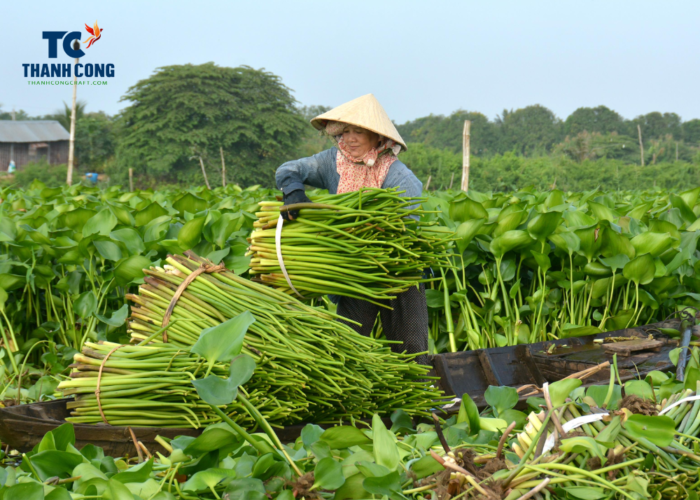
Step 2: Weaving Water Hyacinth Basket
Once the materials have undergone processing, drying, and moisture prevention, skilled artisans proceed to weave a basket.
There are currently over 10 different weaving styles, such as fishbone weaving, checkerboard patterns, floral designs, and more. Each weaving style produces a unique and visually appealing end product.
You can absolutely make your own diy water hyacinth basket through these simple steps:
- Create the Base: To begin making a water hyacinth basket, lay out a few stalks parallel to each other on a flat surface. These will form the base of your basket. Start weaving additional stalks perpendicular to the base stalks. Weave them in and out to create a tight weave. This is the foundation of your basket.
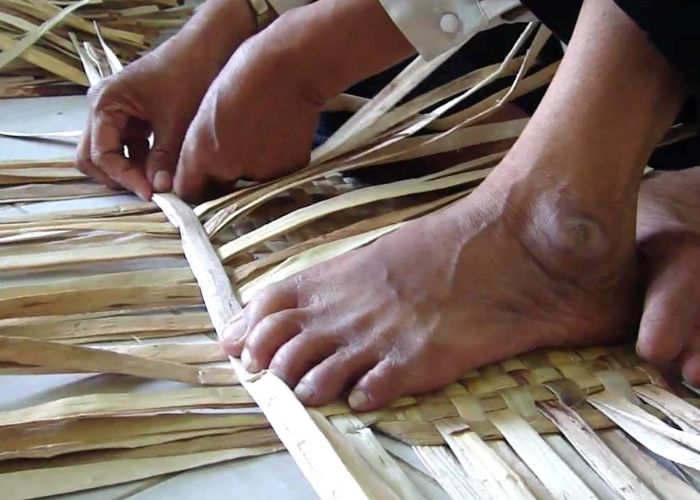
- Build the Sides: Continue adding more stalks around the perimeter of the base, gradually building up the sides of the basket. Weave them tightly to ensure the basket is sturdy. You can vary the pattern or color by adding different colored stalks or twisting them together.
- Add Handles (Optional): If you want to add handles to your basket, leave gaps in the sides where you want the handles to be. Then, create loops using the water hyacinth stalks and secure them to the basket.
Step 3: Cleaning the Finished Products
Once your water hyacinth basket has undergone the weaving and drying processes, it’s essential to ensure that it’s clean and ready for use. This step helps eliminate surface dirt and prevents it from getting trapped during deeper cleaning.
Step 4: Moisture Inspection and Storage
After the water hyacinth basket has been meticulously crafted, the final step is to inspect its moisture content and ensure proper storage. This step is crucial for preserving the quality and longevity of your handmade creation.
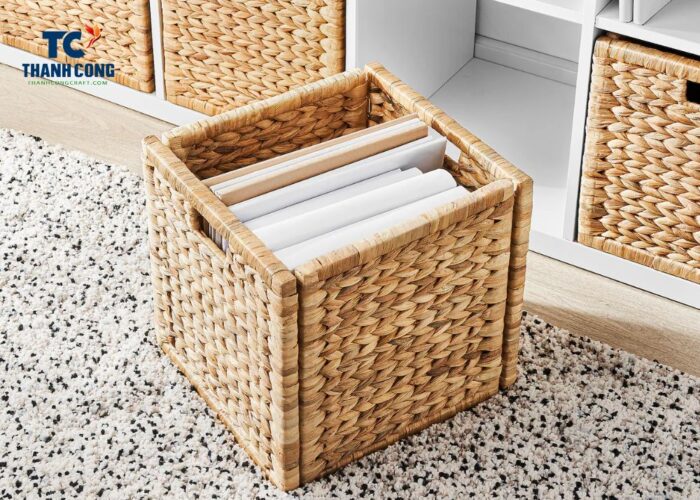
Step 5: Adding Patterns to the Baskets
Once the products meet quality standards, patterns are added to the baskets based on customer preferences. These patterns can include lace, dried flowers, or hand-painted designs, making the products more vibrant, attractive, and diverse.
2. Water Hyacinth Weaving Styles
Here are some common weaving styles for water hyacinth baskets that you can take inspiration from
- Rolled Weave: Rolled weave has the highest production cost in comparison to other water hyacinth weaving styles. To make rolled weave, artisans first roll water hyacinth stalks around a core (this core includes multiple seagrass strands) into a fine rope. These ropes are then linked together with/without a metal frame to create a product.
- Twisted Weave: In Vietnam, artisans often twist 2 or 3 water hyacinth stalks together, then craft or sew into baskets. There are many diameters of twisted water hyacinth ropes. Twisted weave looks much like rolled weave, but the sharp difference is its smaller rope diameter and a wider range of patterns for products.
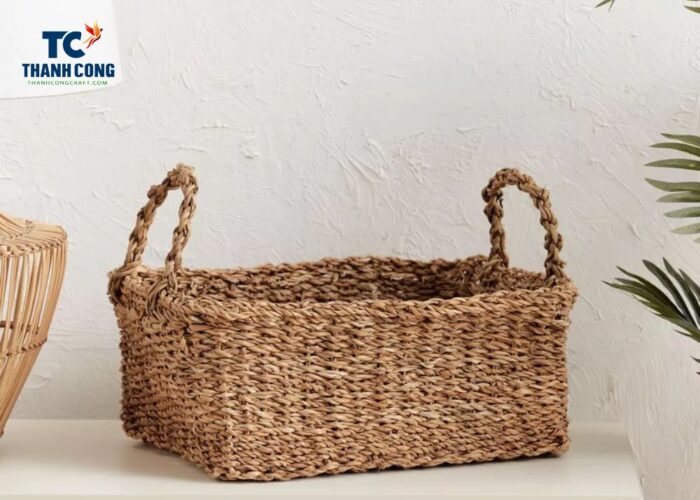
- Braided Weave: The name ‘Braided weave’ refers to the technique of braiding three or five water hyacinth stalks into a rope. Afterwards, these ropes are either woven or sewn into a product.
- Arrow Weave: Arrow weave is another traditional style that local artisans commonly apply for products. Artisans twin two water hyacinth stalks to create this weave that looks like an arrow or fishbone. You might see this weaving style as it’s very popular.
- Open Asterisk Weave: Open asterisk weave is made by weaving multiple water hyacinth stalks over a metal frame to create asterisk patterns with open holes.
They will allow products to get better ventilation and reduce the risk of developing mold. Metal frames are required for this weave, since without a metal frame, water hyacinth baskets will lose form, and cannot function well.
3. Advantages of Water Hyacinth Baskets
While PU leather baskets may start peeling and cracking after just a few months of use, these water hyacinth baskets can last up to 5 years with proper care, simply by storing them in a dry and well-ventilated area.
They remain in pristine condition, and their lifespan is significantly extended. Water hyacinth baskets are suitable for various purposes, whether it’s going out for a stroll, shopping, or a trip to the market. They are also eco-friendly and naturally biodegradable when left in the natural environment.
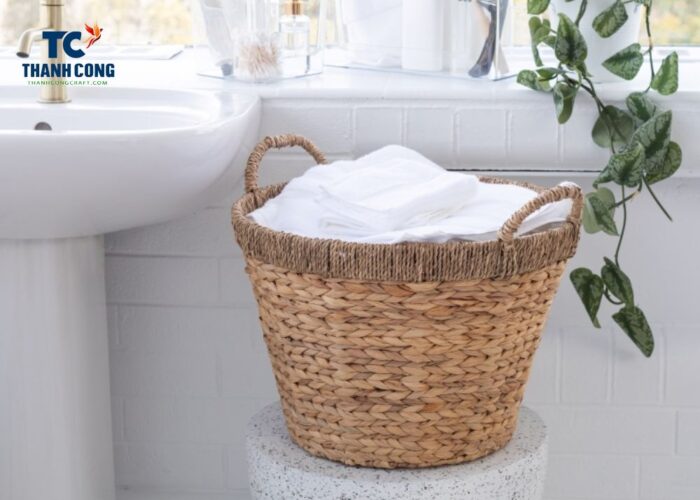
With a diverse range of styles, these products are constantly updated to cater to consumer preferences. Water hyacinth baskets effortlessly complement various fashion trends. You can use water hyacinth baskets for travel or beach outings without worrying about water damage – they remain intact even when exposed to water.
Simply air-dry them, and they’re good as new. These baskets are reasonably priced, as their source material is readily available in nature. Prices start at just a few hundred thousand dong, making it easy to own an environmentally friendly and beautiful basket.
Crafted from 100% natural materials, these handmade artisanal products are incredibly environmentally friendly. Throughout the production process, no chemicals are used, ensuring no adverse impact on the environment.
4. Maintain Your Water Hyacinth Baskets
Dust and debris can accumulate on the surface of your baskets. Wipe them down with a dry or slightly damp cloth regularly to keep them clean and free from dirt. Water hyacinth can be sensitive to moisture, so it’s essential to keep your baskets dry. Avoid placing them in damp or humid areas. If they do get wet, ensure they are thoroughly dried to prevent mold growth.
Prolonged exposure to direct sunlight can cause natural fibers like water hyacinth to become brittle and lose their color. Store your baskets away from direct sunlight when not in use.
If you plan to use your baskets for storing items with sharp edges or liquids, consider using liners to protect the baskets from damage. Regularly check your baskets for any signs of mold or mildew. If you spot any, clean the affected area immediately and ensure the baskets are thoroughly dried.
In conclusion, these baskets not only showcase the beauty of natural materials but also provide a sustainable and versatile storage solution. So, why not give it a try and enjoy the process of turning a simple plant into a functional and beautiful piece of art?
The above article is about “how to make water hyacinth basket“. If you have any further questions, don’t hesitate to send thanhcongcraft an email us at info@thanhcongcraft.com or message us at WhatsApp: +84967485411. Hope to serve you soon! Best regard!


